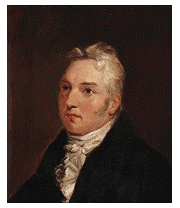Module 2: Section 2
Looking at Samples
 "I wish our clever young poets would remember my homely definitions of prose and poetry; that is, prose = words in their best order; poetry = the best words in their best order." Samuel Taylor Coleridge, from Table Talk, 1827
"I wish our clever young poets would remember my homely definitions of prose and poetry; that is, prose = words in their best order; poetry = the best words in their best order." Samuel Taylor Coleridge, from Table Talk, 1827
No one could have stated a better tribute to organization than Coleridge, the great English Romantic poet. Previously, you reviewed several writing samples to begin thinking about how a writer develops strong ideas. Now, review some samples to recognize how a writer organizes his/her words, sentences and paragraphs in order to present information. Also, the concept of logic was introduced. Logic is the basic premise behind strong organization. If a speaker or writer presents ideas in a logical sequence, the audience will have no trouble following. As always, a writer should keep in mind his/her purpose and audience.
The 6+1 Traits Rubric describes "organization" in writing as:
"This is the internal structure of the piece. The writer has chosen to present materials in an order that enhances the sense of the writing and supports the ideas. Sections are clearly connected, and the development follows a logical pattern. An effective ending brings a sense of closure and resolution."
Part I: Reading Activity. Writing Clear Directions.
Read the three writing samples below. As you read, ask yourself these questions: the segment from the rubric. Make judgments about whether, according to the rubric, the samples are logically organized. Break down this activity by answering these questions:
- How are the writing samples organized?
- If directions are given, are steps presented in a logical way?
- Does the writing make sense?
- What is the writer's purpose?
- Who is the audience?
- Is there a clear structure to the presentation of ideas?
- Are ideas clearly connected?
- Can you easily follow a logical process here?
- What information came too late? Too early?
- What information was missing?
- Where did you become confused? Why?
Ways to Organize Your Writing:
Process Analysis
There are many ways to organize your writing. Examples #1 (PBJ Crumble Bars Recipe) and #3 (“Learning to Drive a Car”) are examples of what is known as a process analysis.
A Process Analyses explains a procedure step-by-step. Inormation can also be presented in chronological order. In addition to specific descriptive language, action verbs, and clear transitions, a good process analysis text has the following components:

Description
Another way to organize writing is by using the descriptive pattern method. Sample #2 is an example of this technique. Descriptive organizations take advantage of your reader’s imagination by appealing to the senses. You literally organize your writing by describing a person, place, thing, or idea!
Example #2 describes a teenager’s bedroom. Imagine your own bedroom. Close your eyes, and see if you can picture it. Imagine that you’re standing in the doorway, looking into your room. How would you describe your room if you:
- Looked at your room from the top (ceiling) to the bottom (floor)?
- Looked at your room from the right side to the left, or left to right?
- Described what is inside your room, and then what’s outside, such as outside the window?
- Described what’s located near to you, and then further away?
- Described what you see, hear, smell, touch, and taste (your senses)?
Here are the five tools of description:
- Sensory imagery (think of all 5 senses when you write a description)
- Comparisons
- Similes [She ran like an ostrich]
- Metaphors [When the ball shattered the glass, the boys turned to statues unsure of what to do next.]
- Personification [The sun smiled down on our picnic]
- Analogies [these are the tools of description.]
- Specific and vivid adjectives and adverbs (sprinkle lightly; do not overdo these)
- Omissions [there wasn’t a cloud in the sky.]
- Fresh ideas [Avoid clichés (comparisons you hear all the time) like the plague.]
Look back at example #2. Can you see evidence of any of these tools? Try to include these in your writing assignments!

